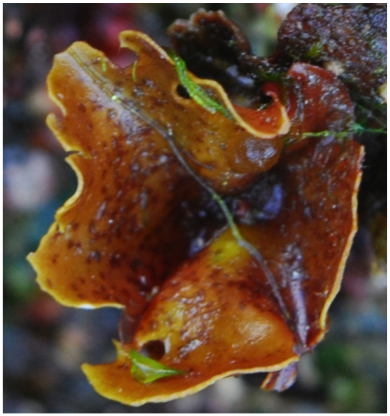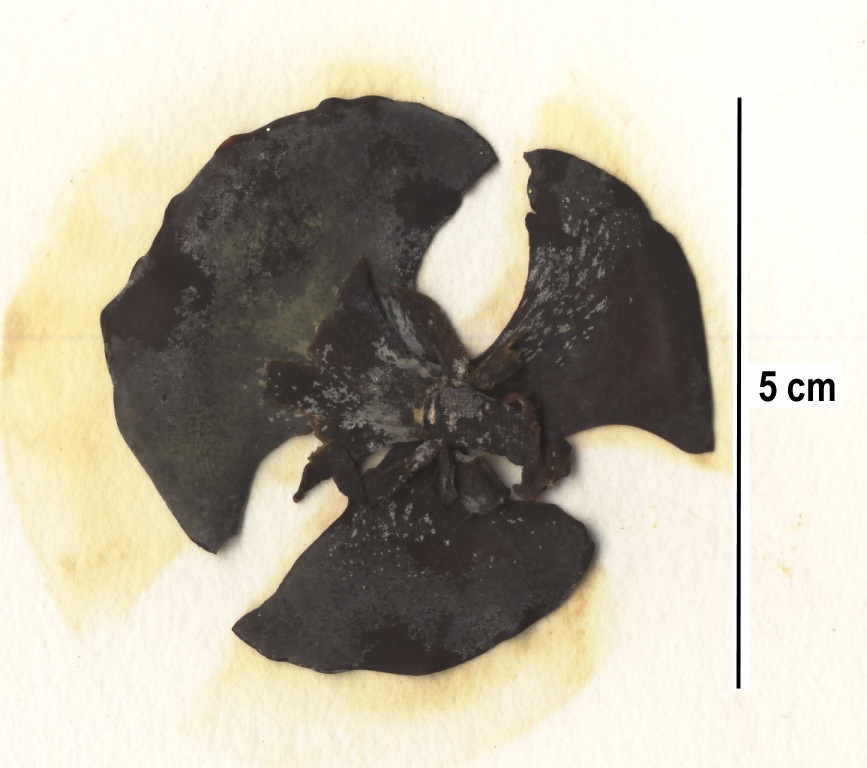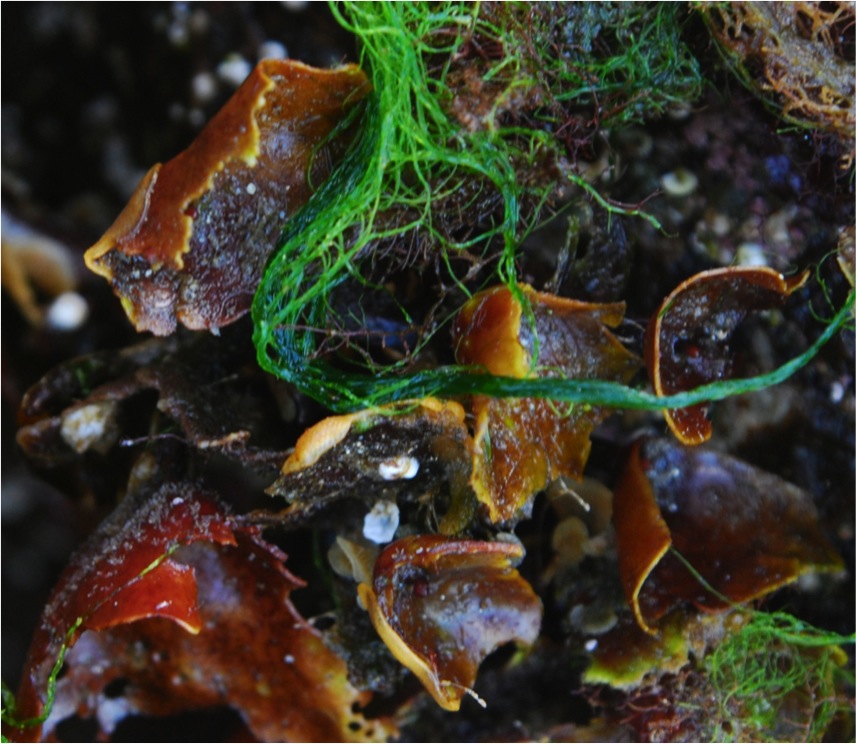Cup and saucer seaweed • Constantinea simplex
{Constantinea = after a phycologist named Constance; simplex = simple; a reference to the seaweed's undivided/unbranched structure}
|
Top left and right: cup and saucer seaweed growing on rock on an exposed Calvert Island beach. Photos by Joel White. Bottom left: specimen from a Calvert Island beach; specimen collection number SCL 15344 in the UBC Herbarium Algae Database. Photo by Sandra Lindstrom. Search the collection number in the database for further details on this specimen, or search this species for additional occurrences.
|
Identification
Cup and saucer seaweed is a whimsically-shaped perennial red algae, with thick blades that somewhat resemble cups and saucers or inside-out umbrellas, depending on the time of year. The dark reddish-brown blades are often split and have conspicuous veins. Each roughly circular blade attaches in a nearly horizontal plane to a cylindrical, unbranched stipe. The stipe attaches to the bottom of the blade in the middle, like a flower stem. A small holdfast attaches the stipe to rock. The blades are less than 15 cm in diameter, with stipes to 15 cm as well.
This species undergoes stipe elongation; a small nubbin at the centre of the blade grows into a new stipe from March until September, at which point a new blade develops. This creates the cup-and-saucer appearance for which the species is named. The previous year's blade gets worn away, leaving a single blade with a flower- or umbrella-like structure.
Habitat & Range
This species grows on rocks in the low intertidal and shallow subtidal along exposed coastlines. Its range extends from the Kamchatka Peninsula, Commander Islands, and Aleutian Islands east to northern Alaska, and south to southern California.
Similar Species
Cracked saucer (Constantinea subulifera) has a similar shape but has a branched stipe. It grows to a much larger size (to 20 cm tall and 30 cm diameter), and is found in more sheltered locations. Northern cup and saucer seaweed (C. rosa-marina) isn't found south of southeastern Alaska; it is also branched, has inconspicious blade veins, and grows to 15 cm tall and 15 cm in diameter.
Intriguing Info
These plants may bear white rings. This discolouration is the result of exposure during low tides.
iNaturalist
https://www.inaturalist.org/taxa/345231-Constantinea-simplex
Cup and saucer seaweed is a whimsically-shaped perennial red algae, with thick blades that somewhat resemble cups and saucers or inside-out umbrellas, depending on the time of year. The dark reddish-brown blades are often split and have conspicuous veins. Each roughly circular blade attaches in a nearly horizontal plane to a cylindrical, unbranched stipe. The stipe attaches to the bottom of the blade in the middle, like a flower stem. A small holdfast attaches the stipe to rock. The blades are less than 15 cm in diameter, with stipes to 15 cm as well.
This species undergoes stipe elongation; a small nubbin at the centre of the blade grows into a new stipe from March until September, at which point a new blade develops. This creates the cup-and-saucer appearance for which the species is named. The previous year's blade gets worn away, leaving a single blade with a flower- or umbrella-like structure.
Habitat & Range
This species grows on rocks in the low intertidal and shallow subtidal along exposed coastlines. Its range extends from the Kamchatka Peninsula, Commander Islands, and Aleutian Islands east to northern Alaska, and south to southern California.
Similar Species
Cracked saucer (Constantinea subulifera) has a similar shape but has a branched stipe. It grows to a much larger size (to 20 cm tall and 30 cm diameter), and is found in more sheltered locations. Northern cup and saucer seaweed (C. rosa-marina) isn't found south of southeastern Alaska; it is also branched, has inconspicious blade veins, and grows to 15 cm tall and 15 cm in diameter.
Intriguing Info
These plants may bear white rings. This discolouration is the result of exposure during low tides.
iNaturalist
https://www.inaturalist.org/taxa/345231-Constantinea-simplex
References
Guiry, M.D. & Guiry, G.M. (2013). Constantinea simplex. AlgaeBase. National University of Ireland, Galway. Accessed 26/08/2014.
Lamb, A., and Hanby, B. (2005). Marine Life of the Pacific Northwest [electronic version]. Madeira Park, BC: Harbour Publishing.
Lindberg, M. and Lindstrom, S. (2010). Constantinea rosa-marina. Seaweeds of Alaska. Accessed 26/08/2014.
Authors and editors of page
Kelly Fretwell, Patrick Martone, and Brian Starzomski (2014).
Guiry, M.D. & Guiry, G.M. (2013). Constantinea simplex. AlgaeBase. National University of Ireland, Galway. Accessed 26/08/2014.
Lamb, A., and Hanby, B. (2005). Marine Life of the Pacific Northwest [electronic version]. Madeira Park, BC: Harbour Publishing.
Lindberg, M. and Lindstrom, S. (2010). Constantinea rosa-marina. Seaweeds of Alaska. Accessed 26/08/2014.
Authors and editors of page
Kelly Fretwell, Patrick Martone, and Brian Starzomski (2014).







